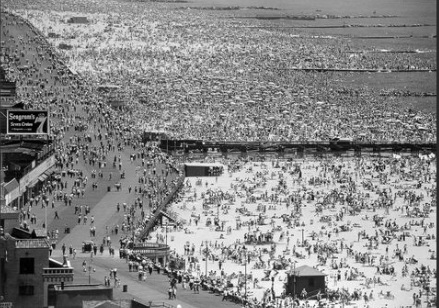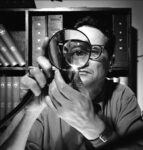
Andreas Feininger
American, 1906 - 1999
Coney Island Beach on the Fourth of July, 1949
gelatin silver print
9 1/2 x 13 1/8 in.
SBMA, Gift of the Artist
1998.56.4

Andreas Feininger looking at negatives with a magnifying glass. (Photo by Andreas Feininger/The LIFE Picture Collection © Meredith Corporation)
“Realism and super-realism are what I am after. This world is full of things the eye doesn’t see. The camera can see more, and often 10 times better.” - Andreas Ferininger
COMMENTS
If one had to choose a single photographer whose work would serve as a visual biography of New York City in its postwar Golden Age when Gotham became, in a sense, the capital of the world, the name Andreas Feininger would have to be in the mix. Paris-born, raised in Germany and, for a time, a cabinet-maker and architect trained in the Bauhaus, Feininger’s pictures of New York in the 1940s and ’50s helped define, for all time, not merely how a great 20th century city looked, but how it imagined itself and its place in the world. With its traffic-jammed streets, gritty waterfronts, iconic bridges and inimitable skyline, the city assumed the character of a vast, vibrant landscape.
Individual New Yorkers, meanwhile, were often an afterthought: it was form, pattern and, perhaps above all else, scale that Feininger sought. Human beings might have built this thrilling, sprawling, purposeful urban panorama, but their presence in Feininger’s pictures was not necessary; their handiwork would suffice. (In fact, in his single most famous portrait of a person, his 1955 photo of the young photographer Dennis Stock, Feininger obscures or, more accurately, replaces the human face with the clean, mechanistic contours of a camera.)
Of course, no one who worked on staff for LIFE as Feininger did for almost two decades—and 340 assignments—from 1943 until 1962, could be defined by a single topic.
Fascinated from the time he was a young boy in Germany by the natural world, Feininger made beautiful pictures of the skeletons and bones of animals, snakes and birds, investing them with an austere power that the creatures perhaps lacked when alive and covered with flesh, fur, feathers or scales. His 1956 picture of Niagara Falls in winter, with two small human forms silhouetted against a scene, might have been lifted from the last Ice Age, while one of his most famous and most frequently reproduced photographs—Route 66 in 1947 Arizona—somehow manages to reference, in a single frame, the allure of the open road, the confluence of the man-made and natural worlds and the myth of the inexhaustible American West.
The author of more than 30 books including at least one acknowledged classic, the autobiography Andreas Feininger: Photographer (1966) Feininger’s photographs were shown in solo and group shows in places as diverse as the Museum of Natural History, the International Center of Photography, MoMa, the Whitney, the Metropolitan, the Smithsonian and in smaller galleries and exhibitions around the world. A retrospective of his six-decade career, featuring 80 of his own favorite black-and-white pictures from 1928 through 1988, toured Europe in the late 1990s.
Andreas Feininger died in Manhattan in February 1999, at the age of 92.
https://www.life.com/people/andreas-feininger-photographer-spotlight/
The biggest pressure-relief valve for New Yorkers broiling under the summer sun was Coney Island. Actually, a huge sandbar between Lower New York Bay and the Atlantic, Coney Island is believed to have derived its name from the Dutch settlers who called the area Konijn Eiland, or Rabbit Island, for the large populations of rabbits that roamed there. In the 19th century, stately hotels with bathhouses catered to New York's wealthiest families while paddlewheelers made the trip over water from Manhattan with loads of day-visitors. Some politically-suspect land grants awarded to developers in the 1870s inaugurated Coney’s first period of popular expansion. Railroads and boulevards were built to the island and racetracks opened in Brighton Beach and nearby Sheepshead Bay. The big names of the gay 9Os—”Diamond Jim” Brady, Lillian Russell—frequented the casinos and restaurants but the area soon disintegrated into a tawdry showcase for prostitutes and peep shows.
Coney Island’s next rejuvenation began in 1920 when completion of subway lines opened the beaches to any rider with a dime for the round trip. The boardwalk was built the following year and immediately Coney gained a fresh reputation as the playground for the millions.
The 40s for Coney Island meant a lush period of unrivaled popularity. The boardwalk drew throngs to its bathhouses, games of chance, sideshows, fortune-tellers, inexpensive restaurants and snack bars with their tempting foods. The tangy sea air was rent with screams and squeals as riders were voluntarily terrified by rollercoasters and other tests of will and sanity—the Cyclone, Thunderbolt, Mile-High-Chaser, Rough Rider, Shoot-the-Chutes and Parachute Jump. Carousel organs pumped into the night competing with honky-tonk dance halls and jazz bands to win the ears of the dizzied patrons.
Coney Island was a perpetual carnival, a celebration that delivered on almost every promise. Only one thing seemed unattainable on that sandy city spit by the sea—a secluded section of beach.
Andreas Feininger and John van Hartz, New York in the Forties, New York: Dover Publications, 1978, p. 143
LIFE’S photographers were known for their images of people, but Andreas Feininger (1906-1999) was a profound exception. His concerns were basically with things, perhaps a continuum from his early career as an architect (he worked for a year with Le Corbusier). “Realism and super-realism are what I am after. This world is full of things the eye doesn’t see. The camera can see more, and often 10 times better.” Yet it wasn’t “photography” he was after, but a photograph: “I want to get shots of the things I’m interested in. I use it as a means to an end.” He combined masterly technique with a discerning eye to produce work that is harmonious and incisive.
https://www.life.com/photographer/andreas-feininger/
